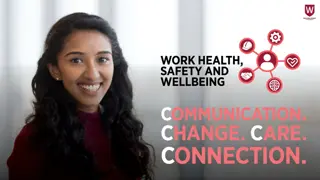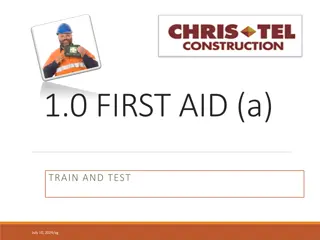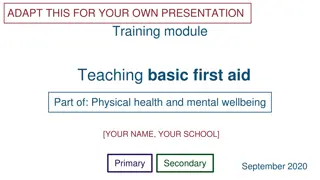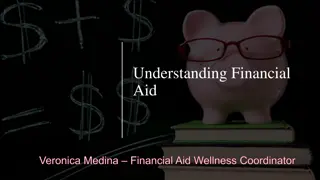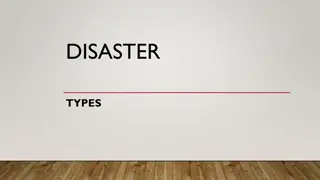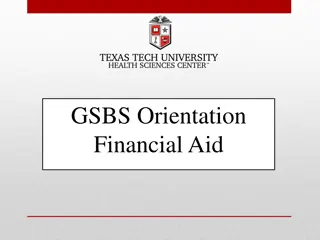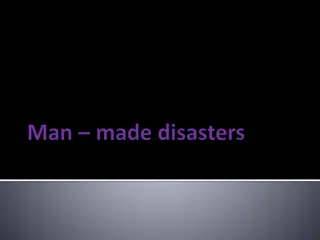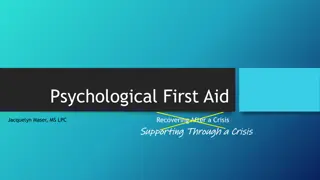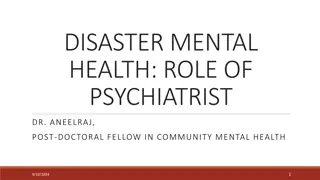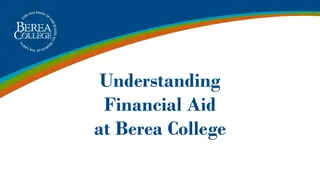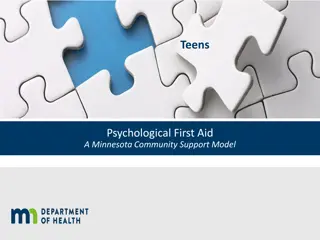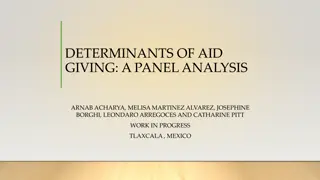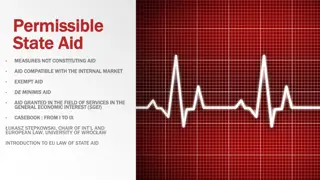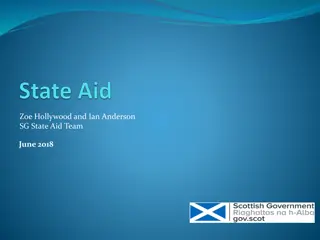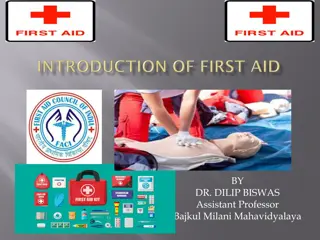Understanding Psychological First Aid in Times of Disasters
Explore the psychological impact of disasters, learn the common reactions, and understand the core actions of Psychological First Aid (PFA). Discover how stress and disasters affect communities and individuals, common reactions to disaster stress, and when professional help may be needed.
Download Presentation

Please find below an Image/Link to download the presentation.
The content on the website is provided AS IS for your information and personal use only. It may not be sold, licensed, or shared on other websites without obtaining consent from the author. Download presentation by click this link. If you encounter any issues during the download, it is possible that the publisher has removed the file from their server.
E N D
Presentation Transcript
PSYCHOLOGICAL FIRST AID Getting through trauma together .
Understand the psychological impact of disasters and recognize the common reactions in self and others. Define the goal and core actions of Psychological First Aid (PFA). OBJECTIVES Prepare to provide immediate support to residents and co- workers experiencing disaster- related stress.
STRESS AND DISASTERS MODULE I
WHAT IS A DISASTER? Wide - scale emergency events that have a severe impact on a community DISASTERS - Traumatize large populations of people at once psychological symptoms Can result in epidemics of survivor guilt and other Create chaotic environment Multiple stressors be a disaster for the survivors A smaller event that impacts just one household or person can
For a community depletion of resources and slow recovery For people Everyone who experiences a disaster is affected in some way Even the helpers! People pull together Stress and grief are common reactions to uncommon situations IMPACT OF DISASTERS
REACTIONS Some people will have severe reactions following a disaster event Most people recover without professional treatment Survivors often to do not seek or accept help, especially from helpers from outside the community
HOW LONG DO THESE THOUGHTS AND FEELINGS LAST? Most people exposed to disasters recover fully from the psychological affects within one year The most intense reactions will lessen over the first few weeks If they persist over 4-6 weeks or are so bad they impair functioning then professional help is needed.
REACTIONS Severe confusion, impaired thinking, distress that cant be calmed, expressed thoughts of self harm or harm to others FACTORS THAT MAY INDICATE THAT PROFESSIONAL HELP IS NEEDED RISK Those that lost a loved one, were injured, believed they were going to die, or saw death of others, extreme community destruction RESILIENCY- Lack good coping skills, has no family support, has experienced other recent traumas prior to the disaster 3 Rs
CHILDREN AND ELDERS CAN BE PARTICULARY SENSITIVE To changes in their routine Separation from familiar environments Watch for delayed reactions of several hours to a few days Separation from familiar people
MODULE 1 QUIZ 1. All people are impacted by a disaster, even those that come to the area help others. True/False 2. All people need professional mental health services after a disaster experience True/False
MODULE 1 QUIZ (cont.) 3. Common reactions after a disaster include: a. Feelings of guilt, anger, hopelessness or a loss of control. b. Difficulty sleeping, remembering, or paying attention c. Headaches, digestive problems, dizziness, tightness in chest d. All of the above 4. What does the 3 Rs stand for? a. Reactions, Risk factors, Resilience factors b. Respect, Reassurance, Regular factors c. Routine, Respect, Rest factors d. None of the above
PSYCHOLOGICAL FIRST AID MODULE 2
PSYCHOLOGICAL FIRST AID (PFA) Is an approach that: Eases suffering of disaster survivors: both physical and emotional Improves survivors short term functioning Promotes emotional recovery after a disaster event
THE GOAL OF PFA Is to promote an environment of: Safety Calm Connectiveness Self-reliance Hope
Helper self-care Offer practical assistance CORE ACTIONS OF PFA Connect with survivors Connect with social supports Safety and comfort Info on coping Stabilization Link to collaborative services Info gathering
THE STRESS OF A DISASTER EVENT IS CONTAGIOUS TO HELP OTHERS YOU MUST MAINTAIN YOUR HEALTH PHYSICAL AND EMOTIONAL TAP INTO YOUR OWN SUPPORT SYSTEMS TO MAINTAIN HOPE TAKE CARE OF YOURSELF! TAKE BREAKS, LEAVE WHEN YOUR SHIFT IS DONE MAINTAIN A HEALTHY ROUTINE KNOW YOUR LIMITS AND GET HELP WHEN NEEDED
MAKE A CONNECTION WITH SURVIVORS Make the first move Intro self and ask permission to talk Ask about their immediate needs Present with an air of patience, compassion, and calm Respect their privacy by finding a quiet place to talk Don t approach too closely or touch them if you are not familiar with their cultural background or personal preferences Protect their confidentiality by sharing their info appropriately
Make sure the environment is safe Help survivors meet their basic immediate needs Offer physical comforts (food, water, blanket, bathroom) Ask about their needs for eye glasses, medications, hearing aids Protect them from additional trauma and trauma reminders (sights and sounds of danger, destruction or suffering) OFFER SAFETY AND COMFORT
SEEK IMMEDIATE PROFESSIONAL HELP IF: The person states a desire to harm themselves or others The person shows signs of shock: Clammy ashen skin Rapid breathing and pulse Nausea /vomiting Faintness, dizziness Extreme agitation
Use a calm and soothing voice Give realistic reassurance What you are feeling is understandable We are here to help STABILIZATION Calm and Orient Survivors Calming techniques include: Cool washcloth to forehead Stretching, head roll Clench and release fists Focus on slow deep breaths Provide repeated, simple and accurate information Rumors and the unknown increase stress
Gather information for identification of their needs Find out the nature and severity of the disaster Those that have been injured or witnessed injury or death are at greater risk for a severe and prolonged distress reaction INFORMATION GATHERING Ask What are your immediate concerns? Listen carefully to identify their physical, medical, emotional needs
INFO GATHERING (Cont.) Don t give simple reassurances like Everything will be ok Listen in a patient and caring way Don t pry or force people to share their stories Some people want to talk and some don t Be patient, and come back a little later if the survivor is not ready to talk
Meet immediate physical needs if possible Clarify what they have told you about their needs and concerns So I heard you say that you are most worried about . Help them problem solve and develop an action plan for next steps Assist them in accomplishing those steps by: Connecting them with internal or external resources Communicating their needs to appropriate members of your team or community OFFER PRACTICAL ASSISTANCE
CONNECTION WITH SOCIAL SUPPORTS Very important to recovery Help survivors contact their family, friends, clergy Sometimes they are reluctant to reach out to loved ones Don t want to be a burden Embarrassed or feel guilty about needing help Help them to work through these concerns Assist them to contact a support person they trust when they are ready
Provide Information on Coping Its normal to feel this way ..
Common Stress Reactions Following Disaster Events Behavioral/Emotional Disorientation/numbness Grief Feeling anxious and fearful Despair/hopelessness Feelings of guilt Feelings of anger Isolation/withdrawl Physical/Cognitive Headaches, stomach aches Difficulty sleeping/eating Exhaustion Bad dreams Intrusive thoughts/images Difficulty concentrating, remembering, making decisions
DO SAY DON T SAY EXPLAIN THAT THESE FEELINGS ARE NORMAL You are not going crazy These kinds of reactions are normal after going through something like this I have some suggestions for techniques to help you feel more calm. Would you like to hear them? You should be feeling better tomorrow Cheer up Maybe you better see a doctor What you need is .. I know what it is like
Deep slow breaths Focus on inhale/exhale Write in a journal Talk to friends/loved ones Stretch exercises Listen to music Reach out for spiritual support Warm bath or shower Make a list of recovery actions Maintain a healthy routine Rest Eat well Drink fluids Exercise Avoid drugs, alcohol, or binge eating Set a small goal for each day related to recovery actions and check off list when done Coping Techniques To Suggest
Link to Collaborative Services Help survivors connect to services related to their needs Medical Financial Spiritual Recovery/replacement assistance related to loss Remember that for most people, PFA is enough Recognize those who need professional help with stress by using the 3 Rs
MODULE 2 QUIZ 1. The purpose of PFA is to: a. b. Prepare you to treat injuries after a disaster. Enable you to persuade someone not to harm themselves after a disaster. Enable to you to provide comfort, care and support to survivors of disasters. None of the above. c. d. 2. Normal survivors are able to function just fine once the disaster is over and they are safe. True/False
QUIZ Module 2 (cont.) 3. What are some examples of effective coping techniques? a. Rest sufficiently, eat well, drink fluids b. Keep feelings to yourself, avoid friends and loved ones c. Focus on slow, deep breaths d. Have a few alcoholic beverages e. a and c.
PRACTICING PSYCHOLOGICAL FIRST MODULE 3 AID
BODY LANGUAGE DO Sit facing the person or beside Give eye contact Show attention by leaning forward DON T Sit back with folded arms Look around distractedly while person is talking Leave while they are talking to you DO S AND DON TS
What to Say Do say Can we talk about what happened? This must be difficult for you. Is there anything I can do for you right now? Its normal to feel this way after something like that. I am here to help you if I can. DO S AND DON Ts
What NOT to say I know what you are going through. Don t feel so bad. You are strong and will get through this. Don t cry, cheer up. Its God s will. It could have been worse. DO S AND DON TS
LEARNING ACTIVITY ROLE PLAY PICK A PARTNER ONE IS SURVIVOR AND ONE IS HELPER SWITCH ROLES FOR ROLE PLAY #2 PRACTICE THE TECHNIQUES YOU HAVE LEARNED
ROLE PLAY #1 This morning there was an earthquake that shook things off shelves, caused the fire sprinklers to go off, and knocked out the power to your facility. Several hours have passed and things have settled down but it is starting to get dark. You notice one of the alert female residents wandering around the halls and refusing to go into her room. Practice the principles of PFA to calm and reassure this person.
ROLE PLAY #2 There was a fire at a nearby nursing home that killed two residents and forced all to evacuate. Your facility has accepted five emergency admits from the burned facility. One of these admits is a male resident whose roommate was killed in the fire. You see him in his wheelchair in the corner of the dining room weeping quietly and muttering to himself. Practice the principles of PFA to calm and comfort him. A few minutes into the conversation he tells you I can t take all this trouble anymore. I just want to die . What is your next step?
Additional PFA Resources National Child Traumatic Stress Network https://learn.nctsn.org/course/index.php?categoryid=11 Minnesota Dept of Health http://www.health.state.mn.us/oep/responsesystems/pfa.html John Hopkins University via Coursera https://www.class- central.com/course/coursera-psychological-first-aid-2900
Disaster Mental Health Services Contact List for California County Mental Health Departments https://www.dhcs.ca.gov/individuals/Pages/MHPContactList.aspx Disaster Distress Helpline SAMHSA 1 800-985-5590 http://disasterdistress.samhsa.gov American Red Cross 1 800-RED CROSS
Questions? Regarding this presentation: Jocelyn Montgomery, PHN jocelynmontgomery@gmail.com Regarding Continuing Education: Cortney Kesterson, CAHF-DPP Coordinator ckesterson@cahf.org



